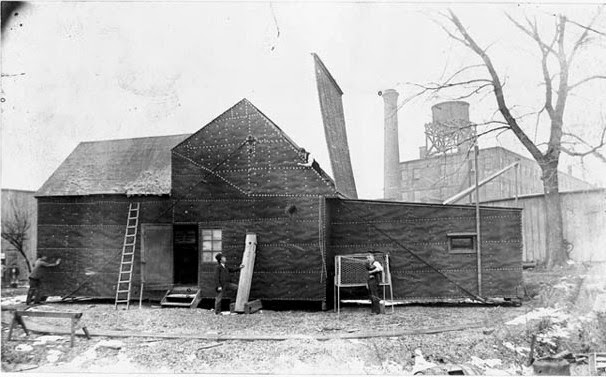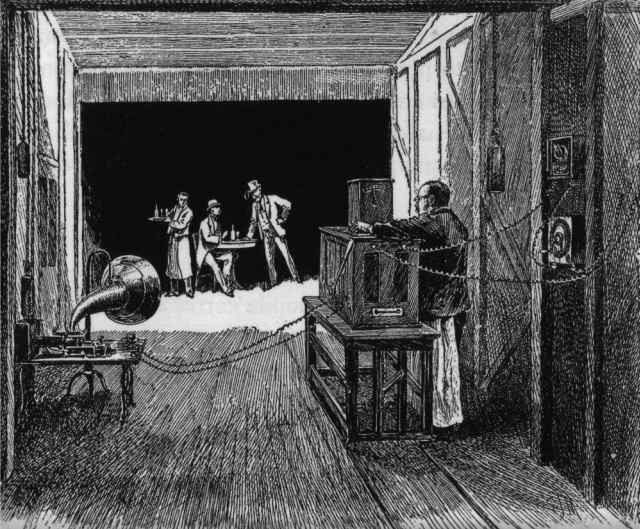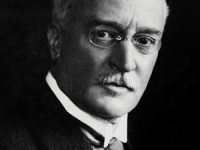
Edison’s Black Maria, the world’s first film studio, ca 1890
On February 1, 1893, America’s First Movie Studio, Thomas Edison’s Black Maria was opened. The Black Maria movie production studio was located in West Orange, New Jersey. But, Black Maria did not produce for the big screen. It was still the times of the so-called kinetoscope, a one person viewing machine, where only one person was able to watch the movie through a peephole viewer window at the top of the device.[1]
The Need for a Motion Picture Production Studio
A constant flow of new film subjects was needed to keep Edison’s new invention popular. Therefore, he decided to build a motion picture production studio at West Orange in December 1892. The studio was dubbed the Black Maria on account of its resemblance to a police patrol wagon (also known as “paddywagons“). But the name did also fit, because Black Maria in the same way as the police wagons was cramped stuffy. According to the staff who worked there, Black Maria was a small and uncomfortable place to work.
Features of the New Studio
The newly developed features of the studio that was covered in black tarpaper, were a roof that could be opened to admit sunlight for illumination, and the building itself was mounted on a revolving pivot so that the structure could be constantly repositioned to keep it aligned with the sun, which by the time the best available source of lighting and because early films required a tremendous amount of bright light. Although the first produced movies were rather short, they were of course subject to copyright. The first motion pictures shot in the Black Maria were deposited for copyright by W. K. L. Dickson at the Library of Congress in August 1893. The earliest copyrighted film that still survives is Edison Kinetoscopic Record of a Sneeze, January 7, 1894, also known as Fred Ott’s Sneeze, which records Fred Ott, an Edison employee, sneezing comically for the camera.

A drawing of the interior (1894), E. J. Meeker (1853-1929) – Century Magazine
A Vaudeville Attraction
As the motion pictures first were supposed to be only a fairground attraction, a series of vaudeville performers became some of the first subjects to appear before the Kinetograph at the Black Maria. These included such well-known acts as the strongman Eugene Sandow, the Spanish dancer Carmencita, and Annabelle Whitford performing her famous Butterfly Dance. Acts from Buffalo Bill’s Wild West Show were filmed, including Annie Oakley and a troop of Native American dancers who performed in the show. Many of the films were expected to appeal to male audiences, and some even featured scantily-clad women. Other masculine activities, such as boxing and cockfights, were also among the more than 75 films produced in 1894.
Commercial Operation
On Saturday, April 14, 1894, Edison’s Kinetoscope began commercial operation. The Holland Brothers opened the first Kinetoscope Parlor in New York City and for the first time, they commercially exhibited movies, as we know them today, in their amusement arcade. Patrons paid 25 cents as the admission charge to view films in five kinetoscope machines placed in two rows. Edison’s Black Maria film studio was used to supply films for this sensational new form of entertainment. More Kinetoscope parlors soon opened in other cities, but already in 1901, the first public film was screened in Oberlin, Ohio, starting the transition from kinetoscope to screen. When Edison built a glass-enclosed rooftop movie studio in New York City, the Black Maria was closed in January 1901 due to the purchase of a new studio in New York, and Edison demolished the building in 1903.
Early Edison Films, 1890’s – Film 19560, [6]
References and Further Reading:
- [1] The Kinetoscope and Edison’s Wrong Way to Invent the Cinema, SciHi Blog, April 14. 2014.
- [2] History of Edison’s Motion Pictures
- [3] The Black Maria Film Festival
- [4] Edison National Historic Site
- [5] Edison’s Black Maria at Wikidata
- [6] Early Edison Films, 1890’s – Film 19560, HuntleyFilmArchives @ youtube
- [7] Wood, Bret. “The Films of Thomas Edison”. Turner Classic Movies.
- [8] Dirks, Tim. “Early Cinematic Origins and the Infancy of Film”. filmsite.org.
- [9] Timeline of Early Cinematographers, born before 1875, via Wikidata






This comment has been removed by the author.
Pingback: Whewell’s Gazette: Year 2, Vol. #30 | Whewell's Ghost
Pingback: Movie Studio Built On Edison Property – Global Firsts and Facts